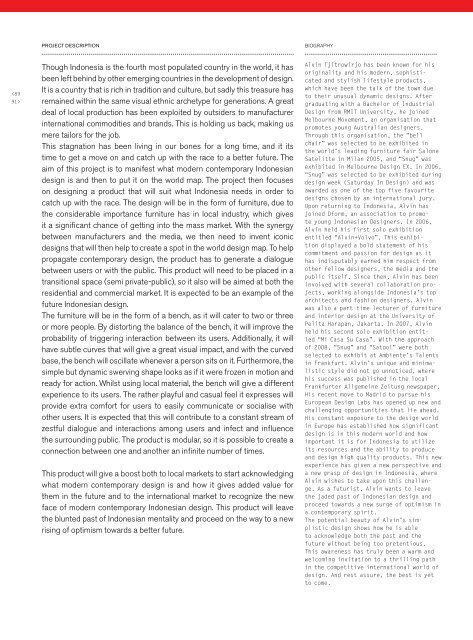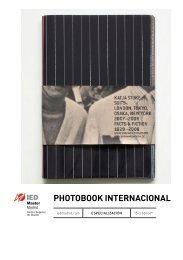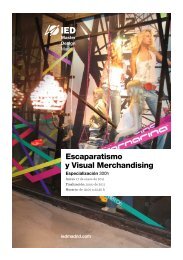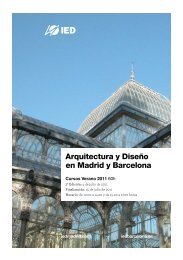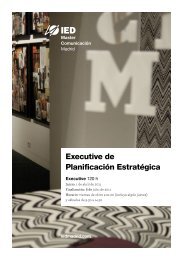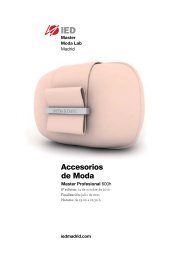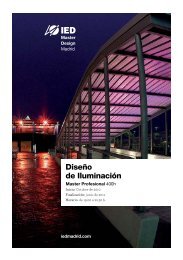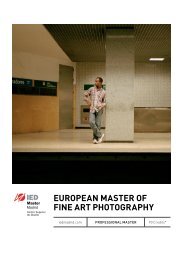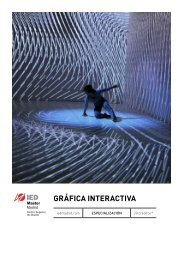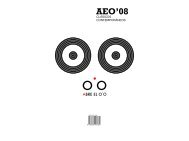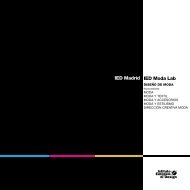trans - IED Madrid
trans - IED Madrid
trans - IED Madrid
You also want an ePaper? Increase the reach of your titles
YUMPU automatically turns print PDFs into web optimized ePapers that Google loves.
project description<br />
biography<br />
<br />
Though Indonesia is the fourth most populated country in the world, it has<br />
been left behind by other emerging countries in the development of design.<br />
It is a country that is rich in tradition and culture, but sadly this treasure has<br />
remained within the same visual ethnic archetype for generations. A great<br />
deal of local production has been exploited by outsiders to manufacturer<br />
international commodities and brands. This is holding us back, making us<br />
mere tailors for the job.<br />
This stagnation has been living in our bones for a long time, and it its<br />
time to get a move on and catch up with the race to a better future. The<br />
aim of this project is to manifest what modern contemporary Indonesian<br />
design is and then to put it on the world map. The project then focuses<br />
on designing a product that will suit what Indonesia needs in order to<br />
catch up with the race. The design will be in the form of furniture, due to<br />
the considerable importance furniture has in local industry, which gives<br />
it a significant chance of getting into the mass market. With the synergy<br />
between manufacturers and the media, we then need to invent iconic<br />
designs that will then help to create a spot in the world design map. To help<br />
propagate contemporary design, the product has to generate a dialogue<br />
between users or with the public. This product will need to be placed in a<br />
<strong>trans</strong>itional space (semi private-public), so it also will be aimed at both the<br />
residential and commercial market. It is expected to be an example of the<br />
future Indonesian design.<br />
The furniture will be in the form of a bench, as it will cater to two or three<br />
or more people. By distorting the balance of the bench, it will improve the<br />
probability of triggering interaction between its users. Additionally, it will<br />
have subtle curves that will give a great visual impact, and with the curved<br />
base, the bench will oscillate whenever a person sits on it. Furthermore, the<br />
simple but dynamic swerving shape looks as if it were frozen in motion and<br />
ready for action. Whilst using local material, the bench will give a different<br />
experience to its users. The rather playful and casual feel it expresses will<br />
provide extra comfort for users to easily communicate or socialise with<br />
other users. It is expected that this will contribute to a constant stream of<br />
zestful dialogue and interactions among users and infect and influence<br />
the surrounding public. The product is modular, so it is possible to create a<br />
connection between one and another an infinite number of times.<br />
This product will give a boost both to local markets to start acknowledging<br />
what modern contemporary design is and how it gives added value for<br />
them in the future and to the international market to recognize the new<br />
face of modern contemporary Indonesian design. This product will leave<br />
the blunted past of Indonesian mentality and proceed on the way to a new<br />
rising of optimism towards a better future.<br />
Alvin Tjitrowirjo has been known for his<br />
originality and his modern, sophisticated<br />
and stylish lifestyle products,<br />
which have been the talk of the town due<br />
to their unusual dynamic designs. After<br />
graduating with a Bachelor of Industrial<br />
Design from RMIT University, he joined<br />
Melbourne Movement, an organisation that<br />
promotes young Australian designers.<br />
Through this organisation, the “bell<br />
chair” was selected to be exhibited in<br />
the world’s leading furniture fair Salone<br />
Satelitte in Milan 2005, and “Snug” was<br />
exhibited in Melbourne Design EX. In 2006,<br />
“Snug” was selected to be exhibited during<br />
design week (Saturday In Design) and was<br />
awarded as one of the top five favourite<br />
designs chosen by an international jury.<br />
Upon returning to Indonesia, Alvin has<br />
joined Dform, an association to promote<br />
young Indonesian Designers. In 2006,<br />
Alvin held his first solo exhibition<br />
entitled “Alvin+Volvo”. This exhibition<br />
displayed a bold statement of his<br />
commitment and passion for design as it<br />
has indisputably earned him respect from<br />
other fellow designers, the media and the<br />
public itself. Since then, Alvin has been<br />
involved with several collaboration projects,<br />
working alongside Indonesia’s top<br />
architects and fashion designers. Alvin<br />
was also a part-time lecturer of furniture<br />
and interior design at the University of<br />
Pelita Harapan, Jakarta. In 2007, Alvin<br />
held his second solo exhibition entitled<br />
“Mi Casa Su Casa”. With the approach<br />
of 2008, “Snug” and “Satool” were both<br />
selected to exhibit at Ambiente’s Talents<br />
in Frankfurt. Alvin’s unique and minimalistic<br />
style did not go unnoticed, where<br />
his success was published in the local<br />
Frankfurter Allgemeine Zeitung newspaper.<br />
His recent move to <strong>Madrid</strong> to pursue his<br />
European Design Labs has opened up new and<br />
challenging opportunities that lie ahead.<br />
His constant exposure to the design world<br />
in Europe has established how significant<br />
design is in this modern world and how<br />
important it is for Indonesia to utilize<br />
its resources and the ability to produce<br />
and design high quality products. This new<br />
experience has given a new perspective and<br />
a new grasp of design in Indonesia, where<br />
Alvin wishes to take upon this challenge.<br />
As a futurist, Alvin wants to leave<br />
the jaded past of Indonesian design and<br />
proceed towards a new surge of optimism in<br />
a contemporary spirit.<br />
The potential beauty of Alvin’s simplistic<br />
design shows how he is able<br />
to acknowledge both the past and the<br />
future without being too pretentious.<br />
This awareness has truly been a warm and<br />
welcoming invitation to a thrilling path<br />
in the competitive international world of<br />
design. And rest assure, the best is yet<br />
to come.


